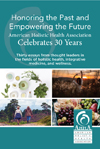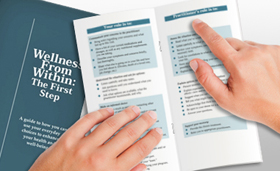American Holistic Health Association
The free, impartial wellness resource connecting you to the power of choice

Special Updates
Archives 2021
Free AHHA monthly Reports
The monthly Special Updates from the AHHA are Reports with items of interest to those actively enhancing their health and well-being. Each Report features a health or health freedom issue. It also features a research item and an AHHA resource.
These free Reports are sent out to subscribers.
You can have these AHHA Special Updates sent to you personally by signing up online.
The Archives of these AHHA Special Reports are maintained here for those who have not yet signed up to receive them by email and those who wish to review past issues.
December 17, 2021
FEATURED RESEARCH
Healthy lifestyle vital for healthy brain
“Lifestyle considerations play a critical role in our brain’s health and its ability to function well. Some genetic factors can play a role in higher risk of AD [Alzheimer’s disease] onset, so does how we live our lives though maintaining a healthy diet, exercising regularly, maintaining a positive outlook on life, and tending to one’s emotional well-being, including managing excessive anger, resentment, and the effects of chronic stress.” From a Townsend Letter research article, “Underlying Causes and Natural Treatments for Alzheimer’s and Dementia” by Michael Edson, MS, LAc.
For other health conditions, check out AHHA’s Evidence-based Research Articles database.
FEATURED ISSUE
Organic milk still not protected
This is an alert for those of you who pay extra for organic milk. There is a loophole in the organic regulations Origin of Livestock Rule that allows some milk to be labeled “organic milk” when it has not passed all organic criteria.
Why the Origin of Livestock Rule?
When the organic rules first came out, there were not yet animals (cows, goats, sheep) that had been evaluated against these new rules to be considered organic. So the government had to figure out steps for conventional dairy livestock to become qualified for organic dairy production. The National Organic Program established an allowance for farmers to convert a specific herd to qualify for organic milk production. This complex, multi-year procedure first “transitioned” the land to gradually incorporate the rules required to be organic. Then the procedure “transitioned” in the animals for a herd. After the full herd had been managed organically for a year on the fully transitioned land, the animals could be certified “organic animals for milk production” (but not for meat production, since the animals were not born and raised organically their entire lives).
The Origin of Livestock Loophole
Some large dairies figured out a loophole so they could continually transition cows into an organic farm. They remove organic calves from an organic farm, raise them elsewhere using less expensive non-organic milk. Then during the important year before they can be milked, they bring the calves back into an organic milking herd. This does not embody the intention of organic standards.
The Solution
Organic industry associations have a history of calling for action for the U.S. Department of Agriculture (USDA) Agricultural Marketing Service to fix the Origin of Livestock Loophole. Here are a couple of specific examples: (1) The Organic Trade Association submitted comments “in support of the proposed rule to clarify and narrow the allowance to transition dairy animals into organic milk production as a one-time event, and urged USDA to move expeditiously to implement the final rule.” (2) The Organic Farmers Association urged “We need the USDA to issue a Final Rule on the Origin of Livestock that is enforceable, consistently interpreted by organic certifiers, stops continuous dairy animal transition, and provides specificity on what the transitioned animals and their progeny can be used for.”
However, three times there have been USDA official proposed Origin of Livestock rule modifications with the accompanying official requests for comments from the industry: in 2015, 2019, and 2021. The proposed 2021 rule modification includes “We are reopening the comment period to solicit views on whether the final rule should prohibit organic dairy operations from acquiring transitioned animals to expand or replace animals to produce organic milk.” Note the 2021 deadline for submitting comments was July 12, 2021. It has been five months since the close of comments and again no action has been taken by the USDA.
In the meantime, some of the large dairy farms are getting bolder in their endeavors to corner the market for organic milk production by undercutting the small and medium-sized organic dairy farms that follow all of the expensive organic regulations.
Issue: Is the organic milk I am buying really organic?
AHHA strives to maintain a neutral position on issues and views knowledge as power. For those interested in this month’s issue, the articles below were selected to support your understanding of some viewpoints on this matter in 2021.
Origin of Livestock Rule (2/20/21)
by Ed Maltby
Organic Farmers Association
National Organic Program; Origin of Livestock; Reopening of Comment Period (5/12/21)
Comments Submittal Deadline: 7/12/21
Federal Register
Origin of Organic Dairy Livestock (May 2021)
Organic Trade Association
Action Alert – Tell USDA to Close Loopholes in Organic Dairy (6/14/21)
National Organic Coalition
Northeast lawmakers urge federal government to close organic loopholes (9/22/21)
by Emma Cotton
VTDigger
You are encouraged to go to our blog at ahha.org/blog and post your comments.
FEATURED AHHA RESOURCE
Your spiritual self
The holistic, or whole person, approach sees “the whole as more than just the sum of its parts.” This means that the whole of you is an integrated union of your physical, mental, emotional, and spiritual selves. AHHA’s website offers a list of books that can support you in developing a richer connection with your spiritual self. Take a look at the books in the Connecting to Your Spirituality database to find the books that will speak to you.
November 19, 2021
FEATURED RESEARCH
How hope impacts cancer outcomes
“If we re-frame our mind to look at the whole person and the environment for what caused the cancer to develop in the first place, then that’s where all these other factors such as stress, diet, environment, the mind, the spirit, and all other aspects of the patient come into play.” from a Townsend Letter research article, “The Biology of Hope” by Leigh Erin Connealy, MD.
For other health conditions, check out AHHA’s Evidence-based Research Articles database.
FEATURED ISSUE
What is the future of cBHRT?
This status update of the U.S. Food and Drug Administration’s (FDA) actions toward eliminating compounded bioidentical hormone replacement therapy (cBHRT) continues the alerts we started reporting three years ago. It is interesting to observe the broad range of groups and individuals who are protesting the FDA’s apparent anti-cBHRT goals.
Click here to refresh your memory of our 11/22/19 alert and our 8/14/20 alert and learn why some individuals are concerned about possibly losing the only HRT product that their system can tolerate.
Links below include one to the full NASEM report that has triggered the controversy.
Issue: Which research on the safety and efficacy of compounded bioidentical hormone replacement therapy (cBHRT) do you view as the most truthful?
AHHA strives to maintain a neutral position on issues and views knowledge as power. For those interested in this month’s issue, the articles below were selected to expand your understanding of what has been unfolding and what are the various factions trying to influence the FDA’s final decision.
What are we talking about?
First educate yourself about what bioidentical hormones are and their various versions.
Why You Need Bioidentical Hormones (updated 11/3/20)
Christiane Northrup, MD
FDA 2018 announcement of two studies assigned to National Academies of Science, Engineering & Medicine
(1) To examine the clinical utility of treating patients with compounded bioidentical hormone replacement therapy (BHRT) products.
(2) To examine available evidence of the safety and effectiveness of multi-ingredient compounded topical pain creams
FDA announces new and expanded compounding research projects (9/26/18)
U.S. Food and Drug Administration
FDA 2020 announcement of NASEM study results stating that there was a lack of rigorous evidence of safety and effectiveness from well-designed or properly controlled clinical studies.
National Academies of Science, Engineering, and Medicine (NASEM) Study on the Clinical Utility of Treating Patients with Compounded “Bioidentical” Hormone Therapy (7/1/20)
U.S. Food and Drug Administration
Actual NASEM report
Clinical Utility of Treating Patients with Compounded “Bioidentical Hormone Replacement Therapy” (2020)
The National Academies of Sciences Engineering and Medicine
Rebuttal comments about NASEM report by coalition of traditional compounding pharmacies
Supplement to August 17, 2020 Comment to FDA Regarding the National Academies of Sciences, Engineering, and Medicine Report on the Clinical Utility of Treating Patients with Compounded “Bioidentical Hormone Replacement Therapy” (3/4/21)
Reed Smith LLP
Advocacy groups point out bias with FDA using NASEM
Bias in Government Group Ruling Against Women’s Health (10/7/21)
Alliance for Natural Health USA
Healthcare professionals registered concerns about NASEM recommendations and offered opposing research results
If We Lose Compounded Bioidentical Hormone Replacement Therapy (May 2021)
Townsend Letter
You are encouraged to go to our blog at ahha.org/blog and post your comments.
FEATURED AHHA RESOURCE
Options to “gift” health
Are you looking for a special holiday gift that will motivate a loved one to pay more attention to their health and well-being? AHHA members have written books and created CDs and DVDs that are filled with tips for improving your health. You can learn more at Health-related Books, CDs, DVDs… and at the Books/ Other Media section of the Self-Help Tools database of AHHA Organizational Members.
October 22, 2021
FEATURED RESEARCH
Versatility of stem cells
“Adult stem cells, especially those found in bone marrow, are a powerful therapeutic modality. Whether they work their healing and restorative “magic” because they engraft and transdifferentiate or differentiate into specific cell types, or secrete paracrine and other factors, or both, the fact is that they get the job done.” from a Townsend Letter research article, “Healing with Stem Cells: My Journey” by David A. Steenblock, MS, DO.
For other health conditions, check out AHHA’s Evidence-based Research Articles database.
FEATURED ISSUE
Toxic environmental exposure as COVID-19 risk factor
Mentioned in the attention focused on COVID-19 are contributing factors that make an individual more at risk for experiencing serious symptoms. In most cases specific diseases are included on a list of these factors: hypertension, diabetes, cardiovascular disease, chronic respiratory disease, immune compromised status, cancer, and obesity. However, some lists also include environment exposures to toxic substances that negatively impact your immune system. To protect against the latter, we rely on a product’s ingredients label and the efforts of the U.S. Environmental Protection Agency (EPA) to identify any chemicals that might pose a potential risk. Therefore, it was alarming last July when charges were made that the EPA might sometimes be removing references to documented harm from their assessment of a chemical. It is encouraging that the EPA announced October 14 that they would be strengthening their chemical safety reviews. In the meantime, if you feel your immune system might be compromised and the reason is not obvious, you might want to take the extra step and research what chemicals are in your environment. Then work with your physician to take protection actions.
Issue: Environmental toxic substance exposures and COVID
AHHA strives to maintain a neutral position on issues and views knowledge as power. For those interested in this month’s issue, the articles below were selected to expand your awareness of contributing factors related to level of severity of COVID-19, plus the evolving situation with EPA chemical assessments.
Toxins as COVID-19 risk factor
The under-reported role of toxic substance exposures in the COVID-19 pandemic (November 2020)
by Ronald N Kostoff, et al.
Food and Chemical Toxicology
Toxic metal exposure as a possible risk factor for COVID-19 and other respiratory infectious diseases (December 2020)
by Anatoly V Skalny, et al.
Food and Chemical Toxicology
EPA hiding toxins?
Whistleblowers Expose EPA Corruption (9/20/21)
Alliance for Natural Health USA
New Evidence of Corruption at EPA Chemicals Division (9/18/21) Part 3 of a series
by Sharon Lerner
The Intercept
EPA plan for reforms
EPA Announces Next Steps to Enhance Scientific Integrity and Strengthen New Chemical Safety Reviews (10/14/21)
U.S. Environmental Protection Agency (EPA)
EPA Plans to Clean Up Troubled Chemical and Pesticide Programs (10/14/21) Part 5 of a series
by Sharon Lerner
The Intercept
You are encouraged to go to our blog at https://ahha.org/blog and post your comments.
FEATURED AHHA RESOURCE
How do YOU define “holistic”?
Have you discovered that others are not defining the term “holistic” the same way you are? AHHA has always recommended that when you’re talking about holistic concepts, it’s wise to define terms and make sure you and the person you are talking to agree on those definitions. AHHA offers articles on this important topic. See the What is Holistic? category in our Self-Help Articles Collection. Perhaps these articles will also help you clarify your own thinking about what “holistic” really means.
September 24, 2021
FEATURED RESEARCH
Don’t let kidney disease stay silent
“What I have come to realize is that there are specific molecules that ‘drive’ kidney disease. When these molecules are elevated, they damage kidney tissue. They ‘bang’ against kidney cells and are the real cause of why potassium levels elevate, protein leaks, and kidney function gets worse.” from a Townsend Letter research article, “Kidney Disease – How to Protect Your Kidneys As You Age and a Call for Functional Renal Medicine” by Devaki Lindsey Berkson, DC.
For other health conditions, check out AHHA’s Evidence-based Research Articles database.
FEATURED ISSUE
COVID-19 booster shots in U.S.
Within a one week time period in late September of 2021, important federal government agency meetings reviewed scientific data and made recommendations related to the future of COVID-19 booster shots for the American public. The following information was compiled to assist you in being able to comprehend what is going on and sift through the vast amounts of data that became available.
* The Food and Drug Administration (FDA) has the task to approve vaccines. The Vaccines and Related Biological Products Advisory Committee (VRBPAC) met September 17 to make non-binding recommendations to the acting FDA commissioner regarding vaccine booster shots. The VRBPAC’s final vote was for extra vaccine dose only for those who are age 65 or older or who run a high risk of severe disease. The acting FDA commissioner sent the official FDA authorization for booster shots to the CDC on September 22. This included the VRBPAC recommendations for boosters for:
1) individuals 65 years of age and older
2) individuals 18 through 64 years of age at high risk of severe COVID-19
3) individuals 18 through 64 years of age whose frequent institutional or occupational exposure to SARS-CoV-2 puts them at high risk of serious complications of COVID-19
* The Centers for Disease Control and Prevention (CDC) has the task to map out the use of FDA approved vaccines. The Advisory Committee on Immunization Practices (ACIP) met September 22 and 23 to make non-binding recommendations to the CDC director on whether or not the CDC should recommend use of the vaccine booster shots the FDA had approved. The recommendations were for a single Pfizer-BioNTech COVID-19 vaccine booster dose at least six months after the primary series under the FDA’s Emergency Use Authorization for:
1) persons aged >65 years and Long Term Care Facility residents
2) persons aged 50-64 years with underlying medical conditions
3) persons based on individual benefit and risk who are aged 18-49 years with underlying medical conditions
The ACIP voted to not include persons aged 18-64 years who are in an occupational or institutional setting where burden of COVID-19 infection and risk of transmission are high.
The next step is up to the CDC director, who may align with the ACIP or add back boosters for healthcare workers, before passing on the final CDC recommendations to the Executive Branch to influence policy making. The CDC director’s decision could come as early as September 24.
Keep in mind that the Executive Branch declared in August 2021 that a national campaign to administer booster shots would begin the week of September 20 based on previous sign offs by the FDA and CDC.
The VRBPAC and ACIP meetings involved a series of presentations from government and industry experts, plus brief public comments with a wide variety of viewpoints. Media articles and videos offer you access to this important information.
You will note:
• The meetings begin with key questions to be addressed. These questions can be significantly modified before the final committee vote.
• Scientific studies can be interpreted differently.
• Age-related risks need credible, specific research results, but sometimes this research is only extrapolated.
• If a specific company’s vaccine approval is still pending, it may not be covered by the recommendations. Thus, the current vaccine boosters under consideration are only for those from Pfizer-BioNTech.
• Weighing potential benefits of a vaccine vs. potential risks can be handled in a variety of ways.
• Some scientific results are devalued because from outside of the U.S.
• Some negative reactions to vaccines are not being researched.
• Some briefing documents say “the FDA has not independently reviewed or verified the underlying data or their conclusions.”
• One FDA leader cautioned against equity as determinant in distribution of available vaccines, such as giving priority to people in developing countries before using vaccine supply for third shots for those in the U.S.
Issue: What is the future of COVID-19 booster shots?
AHHA strives to maintain a neutral position on issues and views knowledge as power. For those interested in this month’s issue, the articles below were selected to support your understanding of this complex matter as federal government regulations evolve and are finalized.
FDA
The VRBPAC meeting video is available for you to explore online:
Virtual Meeting: Vaccines and Related Biological Products Advisory Committee (9/17/21) [08:09:40] [Open Public Hearing speakers 04:00:52 to 04:59:58]
FDA
Tracking the FDA advisory panel meeting on Covid-19 booster shots (9/17/21)
by Helen Branswell, Matthew Herper
STAT
Top doctors say not so fast to Biden’s boosters-for-all plan (9/18/210)
9NEWS
US Panel Recommends Pfizer Covid Boosters For Only Elderly, People At High Risk (9/18/21)
NDTV
FDA Authorizes Booster Dose of Pfizer-BioNTech COVID-19 Vaccine for Certain Populations (9/22/21)
FDA
CDC
The ACIP meetings videos are partially available for you to explore online:
Advisory Committee on Immunization Practices-ACIP (9/23/21)
[04:48:45] [Open Comments 05:17 to 40:01]
PBS News Hour
Advisory committee recommends wide swath of Americans be offered Covid-19 vaccine boosters (9/23/21)
by Helen Branswell
STAT
CDC panel approves boosters for elderly, holds back on health care workers (9/23/21)
by Lauren Gardner
Politico
Agenda of Advisory Committee on Immunization Practices – September 22-23, 2021
CDC
ACIP Presentation Slides: September 22-23, 2021
CDC
FEATURED AHHA RESOURCE
How to find a progressive physician
Are you searching for a medical doctor who delivers care that is more than just drugs and surgery? Check our Holistic Practitioners database. But if this does not help you locate such a physician in your geographic area, consulting the Practitioner Referral Sources list is a useful next step. This list includes a wide variety of healthcare modality associations that give referrals, some of which are exclusively for medical doctors. Physicians who are affiliated with the organizations in our databases are definitely the open-minded, progressive ones who have gone beyond drugs and surgery. Where else but with AHHA can you find so many of these special physicians so easily?
August 16, 2021
FEATURED RESEARCH
Why your lifestyle choices are so important
“While it may seem obvious that overconsumption of calorie-dense food is the root cause [of many chronic diseases], it turns out to be much more complicated. Other key contributory insults include poor sleep combined with high stress, environmental toxicants (chemicals that are detrimental to health), poor exercise habits, and a mismatch of activity to circadian rhythms.” from a Townsend Letter research article, “Metabolic Flexibility – How to Reverse Metabolic Inflexibility to Heal Chronic Disease” by Bonnie Nedrow, ND.
For other health conditions, check out AHHA’s Evidence-based Research Articles database.
FEATURED ISSUE
Will NAC end up as drug or dietary supplement?
Have you noticed that it has become very difficult to find retailers where you can purchase the antioxidant dietary supplement N-acetylcysteine (NAC)? The reason is that last summer (2020) with no advanced warning the Center for Food Safety and Applied Nutrition (CFSAN) sent out a number of letters advising companies that the U.S. Food and Drug Administration (FDA) was designating NAC as a drug, not a dietary supplement. This sent shock waves throughout the supplement industry, as the FDA had been allowing NAC dietary supplement status for 57 years.
Assuming the policy change would be finalized, some retailers immediately stopped selling any product containing NAC. The Natural Products Industry advised their retailers to continue selling products with NAC, however, as they could not see this policy change being legally upheld. As of the summer of 2021, the matter is still in limbo.
Industry organizations like the Council for Responsible Nutrition have submitted petitions to the FDA outlining the legal rationale against the FDA’s arguments supporting their change in policy against NAC. Senator Mike Lee of Utah has submitted a letter to the FDA requesting explanations for this policy regarding NAC.
As the legal arguments are complex, who knows when this matter will be resolved and whether or not reason or special interests will prevail.
Issue: NAC designation change from dietary supplement to drug
AHHA strives to maintain a neutral position on issues and views knowledge as power. For those interested in this month’s issue, the articles below were selected to support your research into the matter presented. Note that this change has been initiated but not yet finalized by the FDA.
LEGAL OVERVIEW
FDA Invokes the Drug Exclusion Provision with NAC over a 57 Year Old Drug (8/2/21)
by Stan Soper
Soper Law
Law firm presenting similar cases for comparison
PRO
Vita Heaven, LLC dba Hangover Heaven (7/29/20)
U.S. Food & Drug Administration
One of the seven warning letters sent out by the FDA in July 2020
Classification of Products as Drugs and Devices and Additional Product Classification Issues (September 2017)
U.S. Food & Drug Administration
Key document used by the FDA
[Note that we could not locate any explanation materials related to the NAC policy change in the FDA website]
CON
Citizen Petition Requesting FDA Allow N-acetyl-L-cysteine (NAC) to be Marketed as a Dietary Supplement (6/1/21)
Council for Responsible Nutrition
CRN’s arguments for why FDA needs to reverse its action against NAC
NAC—The Latest Health-Success Story to Become an FDA Target (7/29/21)
by Scott C. Tips
WholeFoods Magazine
A variety of industry reactions to the FDA action against NAC
NAC Letter (7/30/21)
Senator Mike Lee
Video referencing letter he sent to FDA asking for explanation for the change in NAC policy and requesting hearings
FEATURED AHHA RESOURCE
Change a life
Check out the AHHA Gift for a Better Life single-sheet flyer that introduces the powerful concept of the holistic approach. It’s available for free!. Who do you know who could benefit from receiving a copy? You can download the flyer and share by emailing it or hand delivering a printed copy (double-sided). It can empower that person’s life. Note that this flyer is available in both English and Spanish.
July 16, 2021
FEATURED RESEARCH
Deep Healing
Consider a recommendation for patients to look for “an irreconcilable conflict that is the underlying basis of their disease.” That they can consider it a positive opportunity that “every one of us has a karmic knot … lurking under the surface of our lives, waiting for the disease that will launch us into discovery.” from a Townsend Letter research article, “To Know Thyself: The Discovery Process” by Robert Kellum, ND, PhD, LAc, LMT.
For other health conditions, check out AHHA’s Evidence-based Research Articles database.
FEATURED ISSUE
Is a 5G antenna coming to your neighborhood?
If you are a techie person, you are probably looking forward to 5G coming to your neighborhood. If, however, you know someone who has experienced negative health effects caused by radiation from 5G antennas, you might not want someone in your neighborhood, particularly a next door neighbor, to allow installation of a neighborhood 5G antenna on their property. Why? Because if the radiation from the antenna caused someone in your home to be sick, you would have no recourse. Here is the explanation: The Federal Communications Commission (FCC) Over-the-Air-Reception-Devices (OTARD) rule change activated on 3/29/21 allows the telecom industry to install carrier-grade fixed-base station antennas on private homes (with the owner’s permission). This rule also allows the telecom company to circumvent the need to meet local zoning and environmental requirements. Restrictive deed covenants, homeowners’ association restrictions, and even state laws are preempted. No permit is required. No notice to neighboring property owners is required. Therefore, those who might be affected by involuntary exposure to possibly harmful radiation have no right to object to or prevent the antenna installation.
The owners of the private property who grant permission for a 5G antenna installation on their private property may not be aware that some interpret the OTARD rule that they (the owners) are liable for any negative health effects experienced by their neighbors due to the radiation from the antenna. As the insurance industry has decided not to offer any liability coverage policies to these owners who allow the antennas to be installed on their private property, we assume that they view this as a potentially serious matter. However, there are others who interpret the OTARD rule as saying that a neighbor cannot sue the owners of the property with the antenna for health-related damage, based on the latest amendment eliminating everyone’s rights to hold anyone liable.
Many municipalities, organizations, and individuals formally objected to the OTARD rule via the public comment process before the rule went into effect in March. To comply with the requirements of the Administrative Procedures Act (APA), the FCC must respond to each of these objections and provide reasoned decision-making. So far, judges have sided with the FCC on all matters. One group, Children’s Health Defense (CHD), has submitted a series of briefs, the most recent on 6/28/21. The FCC’s response brief is due on 8/23/21, and CHD will need to reply to the FCC’s brief by 9/14/21. A three-judge panel will be assigned to the case after the conclusion of the briefing stage. Their final decision with be interesting.
Issue: Do you welcome a 5G antenna being installed in your neighbor’s yard?
AHHA strives to maintain a neutral position on issues and views knowledge as power. For those interested in this month’s issue, the articles below were selected to support your research into the matter presented. You will note that we did not include the extensive issue of the status of safety testing for 5G technology.
Pro
OTARD Rule as of 2/25/21…
FCC Modernizes Siting Rule for Small Hub and Relay Wireless Antennas (2/25/21; effective 3/29/21)
Federal Register
Is There a 5G Cellular Network Near You? (updated 6/26/21)
by Bree Fowler
Consumer Report
Con
Example of series of objections by one organization…
CHD v. FCC – Stopping OTARD (2/26/21)
The Defender: Children’s Health Defense
In ‘Disheartening’ Ruling, Court Paves Way for Deployment of 5G Wireless Antennas on Private Property (3/30/21)
The Defender: Children’s Health Defense
Principal Brief Filed in Children’s Health Defense’s Case Against FCC Rule Allowing Base Station Antennas on Homes (6/28/21)
The Defender: Children’s Health Defense
As always, you are encouraged to go to our blog at https://ahha.org/blog and post your comments.
FEATURED AHHA RESOURCE
Your Power of Choice
More and more diseases are being documented as being the result of poor lifestyle choices. AHHA’s booklet, Wellness From Within: The First Step, reminds you of the power of the decisions you make throughout the day. Take time to review the options included in this FREE booklet and choose to change one thing in your everyday routine. Check out the various formats of the booklet, which is available online in English, Spanish, and MP3 format.
June 11, 2021
FEATURED RESEARCH
Hydrogen peroxide as the body’s natural antibiotic
“The only way to stop the COVID-19 pandemic, as well as to prevent or deal with any such future calamities, is to apply a therapy that is highly effective, completely nontoxic, readily available, and inexpensive. Lacking any one of these four aspects of a potential therapy can cripple how well a pandemic can be promptly and readily resolved.” from a Townsend Letter research article, “Curing Viruses with Hydrogen Peroxide – Can a Simple Therapy Stop the Pandemic?” by Thomas E. Levy, MD, JD.
For other health conditions, check out AHHA’s Evidence-based Research Articles database.
FEATURED ISSUE
Sunscreen safety
Our perception of sunscreen safety dramaticallly changed in early 2020 when research funded by the US Food and Drug Administration (FDA) showed that some sunscreen active ingredients are not only systemically absorbed by the body in substantial amounts, but they can also stay there for days. And the biological effect is unknown. The good news is that not all categories of sunscreen products include the ingredients of major concern. The bad news is that these ingredients are in the majority of products. Those in the popular category of “chemical” sunscreen products do include the chemical ultraviolet (UV) filter ingredients avobenzone, oxybenzone, octocrylene, ecamsule, homosalate, octisalate, and/or octinoxate. While the FDA asked sunscreen manufacturers to conduct additional testing of their chemical ingredients to see which can be designated GRASE (Generally Regarded As Safe and Effective), it appears that this testing has not yet taken place.
Here are your three primary choices:
- Chemical sunscreen products absorb into the skin and then absorb UV rays, convert the sun’s rays into heat, and finally release them from the body. Chemical sunscreen ingredients commonly used in the U.S. are ensulizole, octisalate, homosalate, octocrylene, octinoxate, oxybenzone, and avobenzone. These get mixed reviews, with most not considered GRASE.
- Mineral (also known as physical) sunscreen products sit on the skin and reflect the sun’s rays. Older versions tend to coat the skin in a visible layer of white residue. Mineral sunscreen ingredients commonly used are titanium dioxide and zinc oxide. These are designated GRASE.
- Natural products using plant-derived oils and extracts are less common and are generally viewed as less effective because they don’t include chemical or mineral ingredients. It is important to consider that environmental and physical factors affect the ability of the plant material to attenuate UV light.
Whichever sunscreen you decide to use, keep in mind that you shouldn’t rely only on sunscreen to prevent overexposure. It’s also important (1) to wear sunglasses, hats, and T-shirts, (2) to stay in the shade, and (3) to avoid the midday sun.
Issue: How safe is the sunscreen you are using?
AHHA strives to maintain a neutral position on issues and views knowledge as power. For those interested in this month’s issue, the articles below were selected to support your research into the safety considerations of the various sunscreen products. As always, discuss any healthcare decisions with your physician.
About studies funded by the US Food and Drug Administration (FDA):
Effect of Sunscreen Application on Plasma Concentration of Sunscreen Active Ingredients: A Randomized Clinical Trial (1/21/20)
by Murali K. Matta, PhD; et al
Journal of the American Medical Association (JAMA)
FDA Sunscreen Report Raises Concern Over Chemicals (1/21/20)
by Brenda Goodman, MA
WebMD
Supportive of Chemical Ingredient Safety:
Is Sunscreen Safe? (2019)
American Academy of Dermatology Association
Safety Considerations of Sunscreens (5/13/21)
by Devin Regan
SkinCancer.net
Supportive of Mineral Ingredient Safety:
The Truth About Mineral vs. Chemical Sunscreens (4/6/21)
by Markham Heid
Elemental
Sunscreen Safety: SPF, UVA, UVB, Oxybenzone & Vitamin D (updated 5/22/20)
Wellness Mama
Supportive of Plants for Sunscreening:
The Sunscreening Properties of Plants
Wholesome Living
Is It Possible to Make a Safe and Effective Sunscreen from Scratch? (7/10/19)
by Debra Rose Wilson, PhD, MSN, RN, IBCLC, AHN-BC, CHT
Healthline
As always, you are encouraged to go to our blog at https://ahha.org/blog and post your comments.
FEATURED AHHA RESOURCE
Do you have any treatment questions?
Perhaps the most important resource created by AHHA is the Treatment Researchers list. This unique list includes organizations whose experts can answer your health questions and research treatment options for any health condition using conventional medicine and/or alternative approaches. If you know of someone dealing with a life-threatening or debilitating diagnosis, it is vital for you to inform him or her of this valuable support option.
May 14, 2021
FEATURED RESEARCH
Power of melatonin
“Melatonin has been shown to be a major regulator of the immune system. Consequently, disease states affecting a wide range of organ systems have been reported as benefiting from melatonin administration.” from a Townsend Letter research article, “Melatonin: More Than Just the Hormone That Regulates Sleep” by Pamela W. Smith, MD, MPH, MS.
For other health conditions, check out AHHA’s Evidence-based Research Articles database.
FEATURED ISSUE
Bioethics & COVID-19
Almost every news item these days is connected in some way to COVID-19 and offers limited or conflicting points of view. When we dig deeper, the role of bioethics becomes apparent and both clarifies and complicates matters. Bioethics is a branch of applied ethics that studies the philosophical, social, and legal issues arising in medicine and the life sciences. Thinking back over the past year of the COVID-19 pandemic, you may recall a number of bioethical issues. In 2020 the key issues involved (1) the allocation and distribution of treatment resources and (2) access to information on alternative treatment approaches. Currently in 2021 the key issues involve (1) allocation and distribution of vaccines and (2) mandating of vaccinations.
Decision makers at all levels of government, medical facilities, workplaces, schools, etc., face bioethical considerations weighing individual rights against the greater good of the community. As you learn of COVID-19 decisions made, you may want to look beyond what is in a news story for the impact on you as an individual and the impact on the community around you. Hopefully, you will find that the needs of all involved are being respected and accommodated. For example, what about those who are not getting vaccinated, such as those who:
- had COVID-19 and have natural anti-bodies
- have existing conditions that increase the odds of a serious negative reaction to a vaccine
- are in a group with low expectation of getting COVID-19, and if they did, a lower expected percentage of COVID-19 complications than the documented percentage of a negative reaction to a vaccine.
Issue: Understanding bioethical decisions related to COVID-19
AHHA strives to maintain a neutral position on issues and views knowledge as power. For those interested in this month’s issue, the articles below were selected to support insights into bioethical considerations related to COVID-19. As always, discuss any healthcare change with your physician.
general COVID-19 bioethics
Ethics and COVID-19
WHO
Bioethics in the Face of the COVID-19 Pandemic (3/12/20)
SALUD
distribution of treatment resources
Ethical Challenges Arising in the COVID-19 Pandemic: An Overview from the Association of Bioethics Program Directors (ABPD) Task Force (July 2020)
by Amy L McGuire, et.al.
PubMed
What the Chaos in Hospitals is Doing to Doctors (Jan/Feb 2021)
by Jordan Kisner
The Atlantic
access to information on alternative treatment approaches
Can Zn Be a Critical Element in COVID-19 Treatment? (5/26/20)
by Mohammad Tariqur Rahman, , Syed Zahir Idid
PubMed
Vitamin D in Prevention and Treatment of COVID-19: Current Perspective and Future Prospects (9/1/20)
by Navya Vyas, et.al.
PubMed
distribution of vaccines
But Is it Fair? Bioethics, COVID-19 Vaccine Distribution, and Advocacy (2/11/21)
by Chen Fang, PharmD,RPh
Infectious Disease Advisor
2021 CCTS Bioethics Forum Wrap-Up (after 3/19/21)
Center for Clinical and Translational Science
mandating of vaccinations
Compulsory COVID-19 Vaccination?
by Gyan Moorthy
Voices in Bioethics
Good reasons to vaccinate: mandatory or payment for risk? (February 2021)
by Julian Savulescu
BMJ Journals
As always, you are encouraged to go to our blog at https://ahha.org/blog and post your comments.
FEATURED AHHA RESOURCE
Do you have any treatment questions?
Perhaps the most important resource created by AHHA is the Treatment Researchers list. This unique list includes organizations whose experts can answer your health questions and research treatment options for any health condition using conventional medicine and/or alternative approaches. If you know of someone dealing with a life-threatening or debilitating diagnosis, it is vital for you to inform him or her of this valuable support option.
April 16, 2021
FEATURED RESEARCH
Wisdom of Mother Nature
“Delayed umbilical cord clamping increases hemoglobin levels at birth and improves iron stores in the first several months of life, which may have a favorable effect on developmental outcomes. There seems to be something inherently logical about the midwives’ practice of waiting (if possible) until the cord has stopped pulsing.” from a Townsend Letter research article, “Delaying Umbilical Cord Clamping: A Traditional Practice Whose Time Has Come” by Alan R. Gaby, MD.
For other health conditions, check out AHHA’s Evidence-based Research Articles database.
FEATURED ISSUE
Which dietary guidelines do you follow?
Are you basing your personal, dietary choices on the “2020–2025 Dietary Guidelines for Americans” as released on 12/28/20? Or perhaps you have been following the media coverage revealing varying degrees of disagreement with these Dietary Guidelines – coming from registered dietitians, nutritionists, chronic disease physicians, academics, policy officials, wellness lobbyists, and other health experts. The Dietary Guidelines provide advice on what to eat and drink to meet nutrient needs, promote health, and prevent disease. They are used to determine what foods are prioritized in all national food programs, including school breakfast and lunch programs and food assistance programs that provide food for over 70 million Americans a year.
The U.S. Department of Agriculture (USDA) and the U.S. Department of Health and Human Services (HHS), who jointly compile this set of Dietary Guidelines every five years, report that everything is based on scientific evidence. Their recommended diet choices are for members of the general U.S. population (1) who are healthy, (2) who are at risk for diet-related diseases (such as heart disease, cancer and obesity), and (3) who are living with these diseases. Most of the guidelines have largely remained the unchanged. However, the 2020-2025 report was expanded to include specific recommendations for pregnant and lactating women and infants and toddlers through 24 months.
Those mildly critical of the latest Dietary Guidelines note that the limits for the four items (sugar, saturated fat, sodium, and alcoholic beverages) that Americans consume too much of were left too high and were not reduced to the amounts recommended by the experts on the 2020 Dietary Guidelines Advisory Committee.
Those more severely critical of the Dietary Guidelines are also concerned with the sugar, saturated fat, sodium, and alcoholic beverages limits. They further point to the ignoring of the importance of dietary supplements at a level sufficient for reducing the risk for chronic diseases. Some even reject all of the Dietary Guidelines recommendations, as they claim that the government’s Dietary Guidelines are the reason why four out of ten Americans are obese.
Here are three of the reasons offered as explanations for the purported flaws in the final version of the guidelines: (1) industry pressure and successful lobbying by special interest groups for leaving higher limits for harmful items; (2) allowing higher limits for harmful items as a deliberate campaign strategy based on gradual behavior changes being more achievable; (3) the two individuals who oversee the guidelines project and make all final decisions are political appointees, not nutrition researchers or physicians.
Issue: Credibility of the U.S. governmental guidelines for eating patterns
AHHA strives to maintain a neutral position on issues and views knowledge as power. For those interested in this month’s issue, the articles below were selected to give you samplings of the varying degrees of disagreement with the 2020–2025 Dietary Guidelines for Americans recommendations as you do your own research. As always, discuss your nutrition plan of action with your physician.
Dietary Guidelines for Americans 2020–2025 (12/28/20)
U.S. Department of Agriculture (USDA)
What’s Changed In the 2020-2025 Dietary Guidelines for Americans? (1/4/21)
by Toby Amidor
Shape
MILDLY CRITICAL:
What Nutrition Pros Think of the New U.S. Dietary Guidelines (1/21/21)
by Colleen De Bellefonds
Well + Good
3 Missteps in the 2020-2025 USDA Dietary Guidelines (2/26/21)
by Isabel Lu
Center for Nutrition Studies
Here’s What’s Wrong With the Newest Dietary Guidelines for Sugar, According to an RD (3/31/21)
by Betty Gold
Real Simple
STRONGLY CRITICAL:
New Dietary Guidelines for Americans (1/25/21)
by Janet Helm, MS, RDN
U.S. News
2020-2025 Dietary Guidelines Not Applicable for Majority of Americans; Not Scoped for 60% of U.S. With at Least One Diet-Related Chronic Disease (12/2920)
Nutrition Coalition
US Diet Advice Still Wrong (1/21/21)
Alliance for Natural Health USA
As always, you are encouraged to go to our blog at https://ahha.org/blog and post your comments
FEATURED AHHA RESOURCE
Your personal healthcare team
Whether your team is one individual or a group of diverse practitioners, the ideal healthcare team is one in which you and your physicians and other healthcare professionals function as partners and everyone espouses a holistic (whole person) approach to creating optimal wellness for you. If this isn’t happening in your case, consider making some changes. A great place to start your search is the AHHA Practitioner Member database.
March 19, 2021
FEATURED RESEARCH
Extend life expectancy
“Taurine is chemically a very simple compound but its effects on cells is both wide-ranging and profound. It is ubiquitous in the tissues of most mammals and is particularly high in cardiac and skeletal muscle as well as the brain, the retina, and other neural tissue. The main source of taurine is dietary and a lack of taurine in the diet can have severe repercussions on health.” From a Townsend Letter research article, “Longevity, Cardiovascular Disease, and Taurine” by Pushpa Larsen, ND.
For other health conditions, check out AHHA’s Evidence-based Research Articles database.
FEATURED ISSUE
News about natural COVID-19 prevention
Everyone is looking for ways to protect themselves and their loved ones from being infected by the COVID-19 virus. By now we are all familiar with about social distancing and wearing masks. Do you find it interesting that there is little news about options for using our body’s built in defense system?
During this past year, a huge number of studies have been done looking to document causes, contributing factors, and treatment options for those with COVID-19. Individuals preferring a holistic/natural approach vs. a pharmaceutical approach may have noticed that news with credible research about the former is hard to find. But there is research that explores preexisting negative health states, such as vitamin D, B, and C deficiencies, that correlate with a patient experiencing more severe COVID-19 symptoms. This suggests the potential for enhancing treatment and prevention plans with simple, inexpensive vitamin therapy. But did you hear about these studies so that you had an opportunity to consider if you were interested in adding vitamins to your personal prevention plan?
The issue this month is a concern about the scarcity of media coverage of the credible research done by unbiased entities validating natural options for improving our chance of staying healthy during this pandemic.
Issue: Are you concerned about the scarcity of positive news related to natural options for preventing COVID-19?
AHHA strives to maintain a neutral position on issues and views knowledge as power. For those interested in this month’s issue, the articles below were selected to show you that there are positive articles related to research on natural protective options. These are presented for you to offer balance to those articles insisting that vitamins are of little value. Happy hunting as you do research toward possibly expanding your personal plan of action for reducing the possibility of catching the virus. As always, discuss your plan of action with your physician.
The Current Coronavirus Pandemic: It’s Likely Caused By More Than One Pathogen And There Is A Missing Antidote (4/26/20)
by Bill Sardi
National Health Federation
[Almost a year ago there was mention of the impact of vitamin deficiencies on COVID-19 survival]
Strong Correlation Between Prevalence of Severe Vitamin D Deficiency and Population Mortality Rate from COVID-19 in Europe (7/1/20)
by Isaac Z. Pugach and Sofya Pugach
medRxiv
[Correlation of vitamin D deficiency significant & deserving of studies toward treatment & prevention]
Vit D Gets Nod from Congress (2/28/21)
Alliance for Natural Health USA
[Researchers and doctors calling on governments to raise the daily recommended intake of vitamin D from 400 IU to 4,000 IU to reduce the severity of COVID-19]
Be well: A potential role for vitamin B in COVID-19 (8/14/20)
by Hira Shakoor, et al.
Maturitas
[Vitamin B status should be assessed in COVID-19 patients and vitamin B could be used as a non-pharmaceutical adjunct to current treatments]
Can vitamin C prevent or treat COVID-19 (coronavirus)? (3/26 /20)
Drugs.com
[People who are deficient in vitamin C could be more at risk of SARS-CoV-2, or of developing severe COVID-19 because their immunity is impaired.]
As always, you are encouraged to go to our blog at https://ahha.org/blog and post your comments.
FEATURED AHHA RESOURCE
Considering a healthcare career?
More and more people are contacting AHHA for information about a healthcare career that includes the holistic health approach. In response to these queries, AHHA has compiled a special section on our website, Career Research, with considerations and resources to support those researching career options. You can share this resource with those friends who may be contemplating a career change to healthcare.
February 12, 2021
FEATURED RESEARCH
Hope for traumatic brain injuries
“In the treatment of traumatic brain injury, the research suggests that hyperbaric oxygen is the most effective therapy currently available at all levels of severity and all time points in the disease process.” Learn about this and other conditions that hyperbaric oxygen therapy (HBOT) can improve (in some cases, when nothing else does). The Townsend Letter research article, “Effectiveness of Hyperbaric Oxygen Therapy for Traumatic Brain Injury: Interview of Paul G. Harch, MD,” written by Nancy Faass, MSW, MPH, includes compelling original research data, as well as original scans documenting improvement.
For other health conditions, check out AHHA’s Evidence-based Research Articles database.
FEATURED ISSUE
Children and antibiotics
As a parent, it can be frightening when your child is dealing with an infection. You may want to become knowledgeable about the pros and cons of including antibiotics in a treatment program before being faced with making a decision regarding your own child. Recent research has widened the range of recommendations related to the use of antibiotics when treating young children. These studies are going beyond avoiding overuse of antibiotics to explaining why they recommend that you not use antibiotics at all with young children.
Issue: Antibiotics safe for young children?
AHHA strives to maintain a neutral position on issues and views knowledge as power. For those interested in this month’s issue the articles cited below were selected to offer you some resources to begin your research to better understand the two very divergent views of whether or not antibiotics can be harmful to young children.
Pro – for using antibiotics
Information About Antibiotic Use in Children (11/16/20)
Drugs.com
Antibiotics are used to fight infections that are caused by bacteria. Your child’s healthcare provider will decide if your child’s illness is caused by bacteria. This decision is based on an exam, your child’s symptoms, or tests that check for bacteria.
Pediatric Treatment Recommendations (2/1/17)
CDC Centers for Disease Control and Prevention
A table that summarizes the most recent principles of appropriate antibiotic prescribing for children obtaining care in an outpatient setting.
Antibiotic Use in Children: Understanding Safe and Effective Antibiotic Care (11/5/20)
University of Pittsburgh Medical Center Health Beat
Antibiotics are effective in fighting bacterial infections, but their overuse has created a problem called antibiotic resistance.
Are Antibiotics Safe for Babies and Toddlers? (7/14/20)
by Colleen de Bellefonds
What To Expect
How to safely use — and avoid the overuse — of antibiotics.
Con – against using antibiotics
Association of Infant Antibiotic Exposure With Childhood Health Outcomes (11/15/20)
Zaira Aversa, MD, PhD, Elizabeth J. Atkinson, MS, Marissa J. Schafer, PhD, Regan N. Theiler, MD, PhD, Walter A. Rocca, MD, Martin J. Blaser, MD, Nathan K. LeBrasseur, PhD
Mayo Clinic Proceedings
To investigate the extent to which antibiotic exposure in the first 2 years of life is associated with the risk of immunological, metabolic, and neurobehavioral health conditions with childhood onset. The present study finds significant associations between early life antibiotic exposure and several distinct health conditions with childhood onset.
Danger of Antibiotics for Children (2019)
Sanuku
It generally takes the first three to five years of life for a child’s gut microbiome to develop fully as a community. In early life, the gut flora plays a critical role in kick-starting a child’s immune system and in programming their metabolism. The use of antibiotics in early childhood impairs this important development. Worse yet, a study published in Nature Communications showed that a child’s gut flora may take at least a year or sometimes up to two years to fully recover from the damage caused by some antibiotics, especially those that are used to treat upper respiratory tract infections.
Parents Unintentionally Harming Children with Nonprescription Antibiotics (1/28/21)
by Joe Thompson
Parentology
“Antibiotics can, unfortunately, kill off a lot of the helpful bacteria that are normally in a child’s body — such as those in the gut — and essential to normal health.” With continued use, the bacteria in a child’s gut could become resistant to that antibiotic. This resistance may then make the child susceptible to future infections, which poses a risk to not just that specific child but other members of the family.
Antibiotics might kill gut bacteria that protect newborn lungs (2/8/17)
NewScientist
Exposure to antibiotics in the womb could permanently weaken the immune system and make lung disease more likely.
As always, you are encouraged to go to our blog at https://ahha.org/blog and post your comments.
FEATURED AHHA RESOURCE
Unique video blurbs
You are invited to view brief educational health-related video clips created by AHHA members in our Self-Help Videos section. These clips, which give tips on health and wellness, are offered to support your journey toward a higher level of wellness.
January 15, 2021
FEATURED RESEARCH
New help for PMS
Overproduction of the enzyme 5-α -reductase in women causes polycystic ovarian syndrome, premenstrual dysphoric disorder, progesterone resistance, and migraine headaches. The a Townsend Letter research article, “The clinical importance of 5alpha-reductase in human health and pathology, part 2: Women – Polycystic Ovarian Syndrome, Premenstural Dysphoric Disorder, hormone replacement therapy and beyond” by Alan B. McDaniel, MD, explains how to identify overproduction and how to treat it.
For other health conditions, check out AHHA’s Evidence-based Research Articles database.
FEATURED ISSUE
How secure is your medical information?
Are you as protective of your medical records as you are of your bank records? As most physicians’ offices are now using Electronic Health Records (EHR) for maintaining your medical history and sharing this data with hospitals and insurers, your medical records are probably being accessed by a number of entities. This means the risk of your medical data getting into the possession of unauthorized individuals is a distinct possibility. Are you motivated to take steps to minimize this happening? A few recommended preventive actions to consider include (1) adding your medical data to what you keep under password-protected security, (2) never sharing your medical information publicly, such as on social media, (3) declining “free” services that offer to store your medical data for you, (4) shredding medical records you are discarding, and (5) becoming familiar with how your physician’s office is handling your EHR.
Issue: Concerned about who is accessing your medical records?
AHHA strives to maintain a neutral position on issues and views knowledge as power. For those interested in this month’s issue the articles cited below were selected to offer you some resources to begin your research to better understand EHR.
11 Myths About HIPAA and Medical Records Privacy for Patients (2/24/20)
by Trisha Torrey
VeryWellHealth
[Better understand your rights under HIPAA]
5 Tips for Securing Patient Privacy and Healthcare Data (1/5/21)
HealthTech
[Steps you hope your physician’s office is following to protect your EHR]
What You Can Do to Protect Your Health Information (9/5/17)
HealthIT.gov
[Protective steps you can take to protect your EHR]
6 Ways To Protect Your Personal Health Information (11/26/12)
by Michelle McNickle
InformationWeek IT Network
[Reminder to get copies of as many of your medical records as you can]
Electronic Health Records Fail to Detect Up to 33% of Medication Errors (5/29/20)
University of Utah Health
[An alert that we need to double-check things ourselves, especially medications]
New Data Rules Could Empower Patients but Undermine Their Privacy (3/9/20)
by Natasha Singer
The New York Times
[Benefits and risks of using a smart phone app to get your medical information]
It’s Time for a New Kind of Electronic Health Record (6/12/20)
by John Glaser
Harvard Business Review
[List of needed long-term EHR improvements indicates what our physicians are facing today]
EMR vs. EHR: what’s the difference?
AthenaHealth
[Difference between an EHR (electronic health record) and an EMR (electronic medical record)]
As always, you are encouraged to go to our blog at https://ahha.org/blog and post your comments.
FEATURED AHHA RESOURCE
Your spiritual self
The holistic, or whole person, approach sees “the whole as more than just the sum of its parts.” This means that the whole of you is an integrated union of your physical, mental, emotional, and spiritual selves. AHHA’s website offers a list of books that can support you in developing a richer connection with your spiritual self. Take a look at the books in the Connecting to Your Spirituality database to find the books that will speak to you.
Special Updates Archives for 2023
Special Updates Archives for 2022
Special Updates Archives for 2021
Special Updates Archives for 2020
Special Updates Archives for 2019
Special Updates Archives for 2018
Special Updates Archives for 2017




















